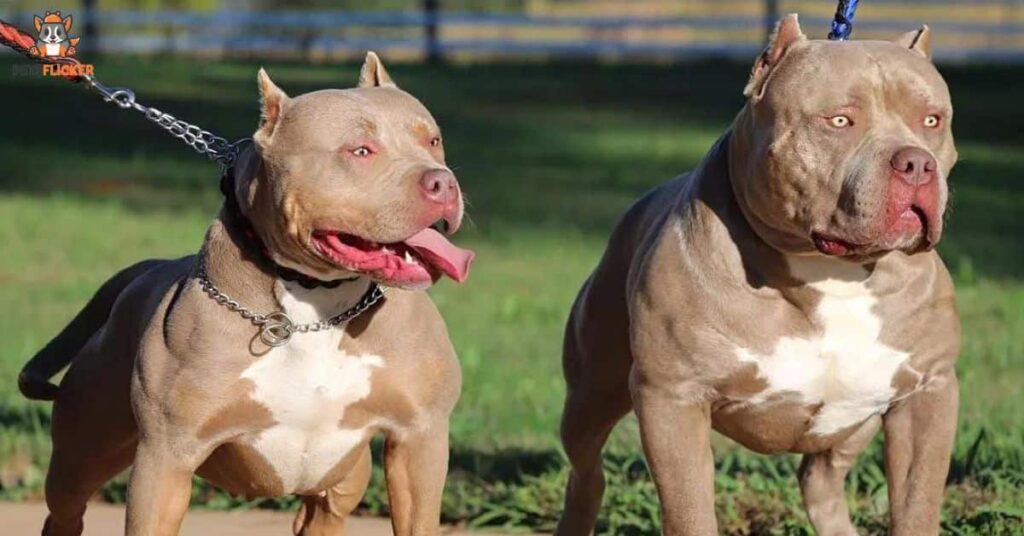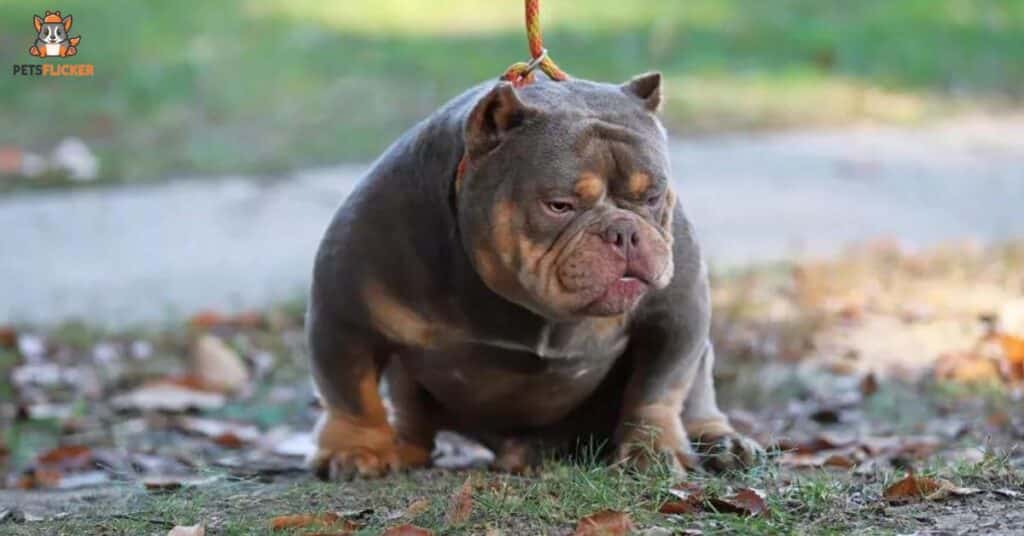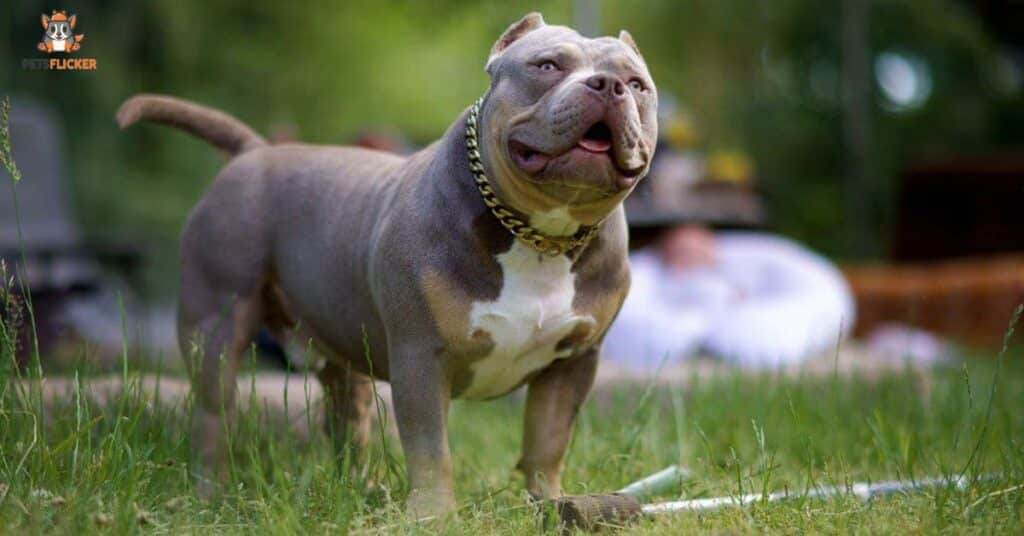American bully is a recent dog breed that emerged in the 1980s, but when we look at it, we sure find it very attractive. When we own one, we are able to have a better understanding of it. We get insight into the temperament, physical qualities and trainability to decide whether it is the right dog for us or not.
There are four main types of American bully. Out of these, the XL bully is the largest, and the micro bully is the smallest. These days, the micro bully mix with XL bully is becoming a popular choice, but it is important to understand this breed.
Although it is possible to breed any dog with another, you need to be aware of the micro bully genetics. Keep in mind that the resulting puppy may face health problems or defects in genetics.
When you breed a micro bully with the largest American bully breed, the XL bully, you will find it reasonable to breed them, as they are of the same breed but different types and the major difference is their height.
Can We Breed A Micro Bully And The Xl Bully?
The world of dog breeding is an intriguing one, filled with possibilities and surprises. Among the many breeds that have captured the hearts of enthusiasts, the American bully stands out as a uniquely fascinating canine.
Within this breed, two distinct varieties have emerged: the micro bully and the XL bully. At first glance, the idea of breeding these two extremes may seem implausible, but the reality is that it’s not only possible but has been attempted by some daring breeders.
The micro bully, also known as the pocket bully or miniature bully, is the smallest variation of the American bully breed. These pint-sized pups typically weigh between 10 and 38 pounds and stand no taller than 16 inches at the shoulder.
Despite their diminutive stature, micro bullies boast a muscular build, a broad chest, and a sturdy frame. They are often described as compact and well-proportioned, making them a popular choice for those seeking a portable yet powerful companion.
On the opposite end of the spectrum lies the XL bully, a true gentle giant among American bullies. These massive canines can weigh anywhere from 80 to 150 pounds and stand up to 23 inches tall at the shoulder.
Their imposing size is complemented by a muscular, athletic build that exudes strength and power. XL bullies are known for their loyal, protective, and affectionate nature, making them excellent family companions when properly socialized and trained.
When Are Male And Female American Bullies Prepared For Mating?

Male Bully Dog
When it comes to breeding American bullies, timing is crucial. Male bully dogs typically reach sexual maturity between the ages of 6 and 12 months, though it’s generally recommended to wait until they are at least 18 months old before considering breeding.
This allows sufficient time for the male to fully develop physically and mentally, ensuring that he is ready to sire healthy offspring.
Reputable breeders often wait even longer, sometimes up to 2 or 3 years, before allowing their male breeding stock to mate.
This extended period allows for more thorough evaluation of temperament, health, and conformity to breed standards, ensuring that only the finest specimens are used for breeding purposes.
Female Bully Dog
Female bully dogs, on the other hand, typically reach sexual maturity between 6 and 12 months of age. However, most responsible breeders recommend waiting until the female is at least 18 months old before allowing her to breed.
This extended period allows her body to fully develop and minimizes the risks associated with breeding too young.
It’s essential to note that while a female bully dog may experience her first heat cycle as early as 6 months old, it’s generally advised to wait until she has gone through at least two or three heat cycles before considering breeding.
This ensures that her reproductive system is fully mature and reduces the likelihood of complications during pregnancy and whelping.
Signs Of Heat That You Should Be Ready For
For breeders considering mating their American bullies, recognizing the signs of heat in the female is crucial. The heat cycle, also known as estrus, typically lasts between 18 and 21 days and occurs approximately every 6 months in most intact female dogs.
During this time, you may notice the following signs:
Swollen vulva
The female’s vulva will appear enlarged and swollen, often accompanied by a bloody discharge.
Increased attentiveness
The female may become more attentive to male dogs and exhibit flirtatious behavior.
Marking behavior
Some females may mark their territory by urinating in various locations.
Restlessness
The female may appear restless or exhibit nesting behavior, indicating her readiness for mating.
It’s crucial to consult with a veterinarian or experienced breeder to determine the optimal time for mating within the heat cycle, as this can vary from one individual to another.
Benefits Of Having Micro Bully Mix With Xl Bully
While breeding a micro bully with an XL bully may seem unconventional, there are potential benefits to this cross. Here are some reasons why breeders might consider this unique pairing:
Genetic diversity
By introducing new genetic material into the breeding program, breeders can potentially improve the overall health and vigor of their litters. This cross-breeding can help reduce the risk of genetic disorders and increase the genetic diversity within the breed.
Size variation
The resulting offspring from a micro bully and XL bully cross may exhibit a range of sizes, allowing breeders to produce puppies that cater to different preferences and needs. Some potential buyers may prefer a medium-sized bully, which could be achieved through this cross.
Temperament balance
Micro bullies are known for their outgoing and energetic personalities, while XL bullies tend to be more laid-back and relaxed. By combining these traits, breeders may be able to produce puppies with a well-balanced temperament, suitable for various lifestyles.
Potential for new bloodlines
Successful crosses between micro bullies and XL bullies could lead to the establishment of new bloodlines within the American bully breed, contributing to its continued evolution and diversity.
Profit potential
As with any breeding endeavor, there is the potential for financial gain if the resulting puppies are in demand and meet the desired criteria of potential buyers.
However, it’s important to note that this cross-breeding should be undertaken with caution and under the guidance of experienced breeders and veterinarians. There are potential risks and challenges associated with breeding two vastly different sizes, which we’ll explore in the following section.
Potential Risks And Challenges

While the prospect of breeding a micro bully with an XL bully may be enticing, it’s essential to consider the potential risks and challenges involved. Here are some factors to keep in mind:
Size disparity
The significant size difference between a micro bully and an XL bully can pose challenges during breeding, pregnancy, and whelping. The size of the puppies may be disproportionate to the size of the mother, increasing the risk of complications during delivery, such as dystocia (difficulty in giving birth).
Health concerns
Breeding two extremes within the same breed can potentially exacerbate certain health issues or genetic disorders. For example, the small size of micro bullies may increase the risk of respiratory problems or skeletal issues, while the larger size of XL bullies could lead to joint problems or heart conditions.
Genetic mutations
When breeding two vastly different sizes, there is a higher risk of genetic mutations or abnormalities in the offspring. These mutations can manifest in physical or behavioral traits, some of which may be undesirable or even detrimental to the health and well-being of the puppies.
Difficulty in predicting traits
Due to the wide genetic variation between micro bullies and XL bullies, it may be challenging to predict the physical and temperamental characteristics of the resulting puppies. This uncertainty can make it difficult for breeders to ensure that the offspring meet desired breed standards or buyer preferences.
Ethical considerations
Some breeders and breed enthusiasts may view the breeding of extremes within the same breed as unethical or detrimental to the overall health and well-being of the breed. This practice could potentially contribute to the propagation of exaggerated traits or health issues.
To mitigate these risks, it’s crucial for breeders to work closely with experienced mentors, veterinarians, and geneticists.
Thorough health screenings, careful selection of breeding stock, and close monitoring during pregnancy and whelping are essential steps to ensure the safety and well-being of both the mother and her offspring.
Also Read This Blog
The Way Forward: Responsible Breeding Practices
While the prospect of breeding a micro bully with an XL bully may seem intriguing, it’s essential to approach this endeavor with caution and a deep commitment to responsible breeding practices. Here are some key considerations for breeders considering this cross:
Health And Temperament Testing
Before breeding, it’s crucial to conduct thorough health screenings and temperament evaluations on both the micro bully and the XL bully. This includes genetic testing, hip and elbow evaluations, cardiac exams, and behavioral assessments to ensure that only the healthiest and most stable individuals are used for breeding.
Selective Breeding Process
Breeders should carefully select breeding stock that exhibits the desired traits and conforms to breed standards. This selective breeding process helps maintain the integrity of the breed while minimizing the risk of propagating undesirable traits or health issues.
Mentor Guidance
Working closely with experienced mentors and reputable breeders can provide invaluable guidance and support throughout the breeding process. Their expertise can help navigate challenges, ensure proper protocols
Veterinary Support
Involving a veterinarian throughout the breeding process is crucial, especially when considering a cross between two extremes.
Veterinary professionals can provide valuable advice on breeding techniques, monitor the health of the breeding stock and offspring, and assist with any potential complications during pregnancy or whelping.
Record Keeping
Meticulous record-keeping is essential in responsible breeding practices. Breeders should maintain detailed records of the breeding stock’s lineage, health screenings, temperament evaluations, and any notable observations or occurrences throughout the breeding process.
This information can help inform future breeding decisions and contribute to the overall knowledge and improvement of the breed.
Socialization And Training
Regardless of the size or breed, proper socialization and training are vital for all puppies. Breeders should ensure that the resulting offspring from a micro bully and XL bully cross are exposed to a variety of sights, sounds, and experiences from an early age to promote well-rounded temperaments and behavior.
Responsible Placement
Finding suitable homes for the puppies is a critical responsibility of responsible breeders. Potential buyers should be thoroughly screened and educated about the unique needs and characteristics of the specific cross. This includes providing guidance on proper care, training, and management of the puppies.
Continuing Education
The world of dog breeding is ever-evolving, with new research and best practices emerging constantly. Breeders should remain committed to ongoing education, attending seminars, workshops, and staying up-to-date with the latest developments in canine genetics, health, and breeding techniques.
By adhering to these responsible breeding practices, breeders can minimize the risks associated with breeding a micro bully with an XL bully and increase the chances of producing healthy, well-adjusted offspring that contribute positively to the American bully breed.
The Future Of Micro Bully And Xl Bully Breeding

As the American bully breed continues to gain popularity, the demand for both micro bullies and XL bullies is likely to grow. However, it’s essential that this demand is met with responsible breeding practices and a commitment to preserving the health and well-being of the breed.
One potential area of focus for breeders could be the development of new bloodlines that combine the desirable traits of micro bullies and XL bullies while minimizing the risks associated with breeding extremes.
This could involve careful selective breeding programs that gradually introduce new genetic material over multiple generations, ultimately producing a more moderate and balanced size variation within the breed.
Additionally, ongoing research and advancements in canine genetics and reproductive technologies may provide new insights and tools for responsible breeders. Techniques such as in vitro fertilization (IVF) or embryo transfer could potentially mitigate some of the risks associated with breeding extremes by allowing for more controlled and selective breeding processes.
Furthermore, as our understanding of canine health and genetics deepens, breeders may be better equipped to identify and address potential health concerns or genetic disorders early on, ensuring that only the healthiest individuals are used for breeding.
Ultimately, the future of micro bully and XL bully breeding lies in the hands of responsible and ethical breeders who prioritize the well-being of the breed over personal gain or novelty.
By working collaboratively with veterinarians, geneticists, and fellow breeders, and by adhering to strict breeding protocols and guidelines, the American bully breed can continue to thrive while maintaining its unique characteristics and diversity.
2024 Update
As we move into 2024, the world of dog breeding continues to evolve, with new developments and advancements shaping the future of responsible breeding practices. Here are some updates and trends to consider:
Increased Focus On Genetic Testing
With the availability of more comprehensive genetic testing panels, breeders now have access to a wealth of information about potential health issues and genetic conditions in their breeding stock. This has led to a greater emphasis on proactive genetic screening and selective breeding to minimize the risk of inherited disorders.
Advancements In Reproductive Technologies
Techniques such as in vitro fertilization (IVF) and embryo transfer have become more accessible and widely adopted by responsible breeders. These technologies offer greater control over the breeding process, allowing for more selective pairings and reducing the risks associated with traditional mating methods.
Stricter Regulations And Oversight
In response to concerns about unethical breeding practices and the propagation of exaggerated traits, many organizations and governing bodies have implemented stricter regulations and guidelines for breeders. This includes mandatory health screenings, temperament evaluations, and adherence to breed standards.
Increased Collaboration Among Breeders
The breeding community has recognized the importance of sharing knowledge and working together to promote responsible practices. Through online forums, breeder networks, and educational workshops, breeders can exchange information, seek guidance, and collaborate on breeding programs that prioritize the health and well-being of the breed.
Growing Demand For Ethical And Transparent Breeding Practices
As public awareness about responsible breeding practices increases, there is a growing demand from potential buyers for transparent and ethical breeding practices. Breeders who prioritize the health and welfare of their breeding stock and puppies, and who are open about their breeding protocols, are likely to gain a competitive advantage in the market.
In the context of breeding micro bullies with XL bullies, these advancements and trends highlight the importance of responsible and well-informed decision-making.
Breeders considering such a cross should prioritize comprehensive genetic testing, collaborate with experienced mentors and veterinarians, and carefully document and monitor the breeding process to ensure the best possible outcomes for both the breeding stock and the resulting puppies.
By staying informed about the latest developments and adhering to ethical and responsible breeding practices, breeders can contribute to the continued evolution and improvement of the American bully breed while prioritizing the health, well-being, and diversity of these remarkable canines.
Conclusion
The future of breeding micro bullies with XL bullies lies in responsible and ethical practices prioritizing the breed’s well-being. Advancements like genetic testing, reproductive technologies, and stricter regulations aim to minimize health risks and inherited disorders.
Increased collaboration among breeders fosters knowledge-sharing and adherence to breed standards. As public awareness grows, there’s a demand for transparent, ethical breeding focused on producing healthy offspring.
By staying informed, utilizing available resources, and making well-informed decisions, breeders can contribute positively to the American bully breed’s evolution while ensuring the puppies’ welfare. Ultimately, responsible breeding with a commitment to health should guide any endeavor involving micro and XL bully crosses.







